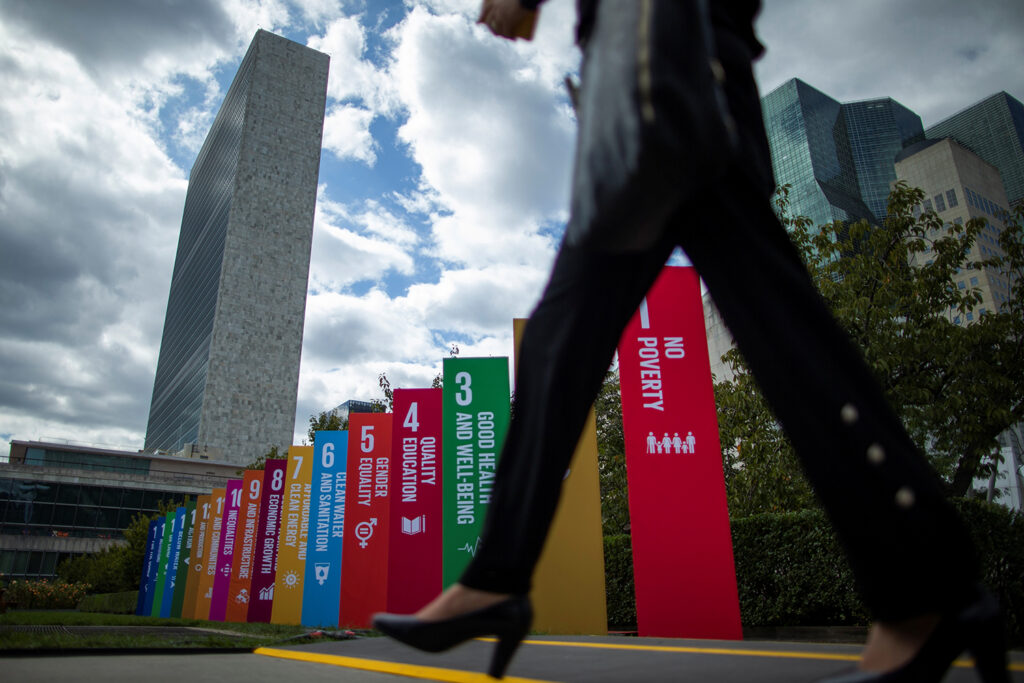Next week, government, finance, and civil-society leaders will convene at the United Nations 4th International Conference on Financing for Development in Seville, Spain. It presents a critical opportunity to alleviate one major constraint on development: Inequitable access to affordable, long-term financing. But unless world leaders adopt a new mindset on development, their efforts may falter.
Access to finance and technology is the most limiting constraint to economic growth and progress toward the 2030 Sustainable Development Goals (SDGs). Nowhere is this constraint more overbearing than in Africa, where the extremely high incidence of sovereign debt has undermined governments’ capacity to invest sustainably in human capital development and research infrastructure. This has suppressed innovation and the building of technological infrastructure, exacerbating gaps (both income and otherwise) between Africa and other parts of the world.
Achieving the SDGs at the global level increasingly depends on progress being made in Africa. To date, however, there has been little to boast about, both across Africa and globally. The welfare gap between Africa and other regions of the world, including regions comprised of developing countries, is enormous and has been widening. Environmental degradation is accelerating. The global annual financing gap for the SDGs is immense, estimated at around four trillion dollars per year through 2030; for Africa alone, that figure sits at $1.3 trillion each year. The existing global financial architecture has drained scarce resources from Africa, exacerbating balance-of-payments constraints in most African countries, some of which have become net creditors to the rest of the world.
Credit rating agencies have inflated risk perceptions for the sixteen African countries that issued bonds, and the cost of such ratings biases is estimated to be $74.5 billion in excess interest and forgone funding. Last year, African governments spent an estimated $163 billion on debt servicing (a significant increase from $61 billion in 2010), dwarfing development financing from international financial institutions. The world’s prevailing development model consistently fails to meet the needs of the present, worsens global inequality and negative externalities, and erodes the long-term wealth of nations. Taken together, these factors jeopardize progress toward the SDGs and undermine the ability of future generations to meet their own needs.
Only 17 percent of the SDGs are currently on track, and more than a third have either stalled or are regressing. Looking at Africa specifically, the number of people falling into poverty has increased sharply in the aftermath of the COVID-19 pandemic, and Africa now accounts for around 55 percent of global poverty. Sub-Saharan Africa is home to more than 237 million children living in extreme poverty (representing more than 71 percent of the global total), up from 210 million in 2013. These realities show setbacks for the first SDG of eradicating poverty.
Dispiriting poverty metrics and limited progress toward the SDGs have been at least partially attributed to the challenging global operating and geopolitical environment. Overlapping health, economic, and social crises resulting from the pandemic—compounded by tightening global financial conditions, rising geopolitical risks and uncertainty (including trade policy uncertainty), and climate catastrophes—have derailed countries’ growth trajectories and undermined progress toward the SDGs, especially in the most vulnerable low-income countries.
Heightened geopolitical tensions are undermining the global cooperation necessary to narrow the SDG financing gap or restructure sovereign debt to reduce the volatility of public spending and attract private investment. Simultaneously, rising protectionism is stifling growth in low-income countries, which rely heavily on trade for economic expansion and foreign exchange reserves. Global volatility is only making the situation worse, especially in the most vulnerable and natural-resource-dependent economies, where the deterioration of commodity terms of trade has been the bane of economic growth, exacerbating internal and external imbalances.
While the UN says that SDG 1 (eradicating poverty) has seen “moderate” and “marginal” progress, such gains are attributed mainly to the spectacular performance of Asia’s emerging market economies. In particular, China has benefited enormously from its integration into global value chains. Over the past forty years, the number of Chinese people living in poverty fell by almost 800 million, meaning China by itself accounted for around three-quarters of the global reduction in the number of people living in extreme poverty.
In China and other high-performing Asian economies that have driven the reduction of global poverty, sustained public investment in human, physical, and digital capital has catalyzed private investment, including large-scale foreign direct investment (FDI). According to recent data, Asia was the destination of more than 71 percent of combined inward FDI in the developing world in 2023, dwarfing Africa’s 6 percent share.
Sustained investment has helped establish Asia’s robust manufacturing base, driving the diversification of growth sources in the region and expanding employment opportunities, thereby strengthening the foundation of macroeconomic stability. And in a generally favorable geopolitical environment of increasing global economic integration and supply-chain optimization, the expansion of manufacturing industries catalyzed technology transfers. This, in turn, further enhanced Asian countries’ integration into global value chains and accelerated income convergence with advanced economies.
Meanwhile, entrenched inequality and the use of technology as a tool for rent-seeking have contributed to the marginalization of Africa in the distribution of global value chains. Indeed, trade in value-added goods is highly concentrated in three regions—Asia, Europe, and North America. Entrenched inequality and rent-seeking have also hindered the expansion of manufacturing industries, which have been key drivers of growth and welfare improvement in low- and middle-income countries.
But amid increasing exports of foreign value-added content, even more enduring economic costs have been imposed on African economies. Higher interest rates on external debt have shrunk fiscal space and locked countries into chronic deficits of human and physical capital, inhibiting FDI inflows and stymying the diversification of growth sources and the expansion of employment opportunities. FDI and diversified growth resources are necessary to catalyze technology transfers and to help the continent enter the global value chain..
Instead of providing African countries with adequate financing of sufficient quality (regarding the cost of capital and maturity of loans), the global financial architecture has subjected them to growth-crushing and default-driven borrowing rates. These increase the fiscal incidence of sovereign debt and undermine countries’ capacity to scale up the investment required to achieve the SDGs. Both African sovereign and corporate entities pay interest charges often 5 to 10 percent higher per year than the borrowing costs paid by advanced economies. Unsurprisingly, paying interest on external debt has become one of the largest expenses for these countries, averaging 14 percent of government spending across the region. Over thirty African countries spent more on debt interest services—excluding principal repayments—than on public healthcare in 2023.
And yet the world contains great wealth, and parts of it are awash with cash. At the end of 2023, total assets under management at the world’s five hundred largest investment managers reached $128 trillion. Developing countries, especially low-income African nations, should not have to choose between paying the interest on their external debt and providing healthcare to their vulnerable population, nor between debt sustainability and sustainable development. In the words of Nelson Mandela, “Like slavery and apartheid, poverty is not natural. It is manmade, and it can be overcome and eradicated by the actions of human beings. And overcoming poverty is not a gesture of charity. It is an act of justice.”
World leaders attending the 4th International Conference on Financing for Development must use the opportunity to transcend the old dichotomic developing/developed country mindset that has underpinned systemic global inequality. They must also take steps to improve access to financing and extend the benefits of education and technology globally. If they don’t, global income convergence will remain elusive, and so will the highly technology-intensive net-zero transition. Until then, progress toward the world’s 2030 Sustainable Development Goals will continue to disappoint.
Hippolyte Fofack, a former chief economist at the African Export-Import Bank, is a Parker fellow with the Sustainable Development Solutions Network at Columbia University, a research associate at Harvard University, a distinguished fellow at the Global Federation of Competitiveness Councils, and a fellow at the African Academy of Sciences.

The Africa Center works to promote dynamic geopolitical partnerships with African states and to redirect US and European policy priorities toward strengthening security and bolstering economic growth and prosperity on the continent.
Further reading
Fri, Jun 27, 2025
Don’t leave Africa behind in sports sustainability—put it first
AfricaSource By
The hosts of the upcoming Olympic Games and FIFA World Cup are committing to sustainability goals inside their countries. But achieving a sustainable sports legacy will take a global approach.
Mon, Jun 23, 2025
African countries must do more to prepare to quickly respond to cyberattacks
AfricaSource By Yasmine Abdillahi
Africa’s digital transformation has made public institutions both more efficient and more vulnerable. And each attack carries political, financial, and reputational consequences.
Thu, Jun 12, 2025
Empower women miners now for a just future in Africa
AfricaSource By
African countries must address the challenges women in mining face with policies that are tailored to the needs of local communities.
Image: A woman walks outside on the grounds of the United Nations headquarters during the 74th session of the United Nations General Assembly in New York City on September 24, 2019. Photo via REUTERS/Eduardo Munoz.




